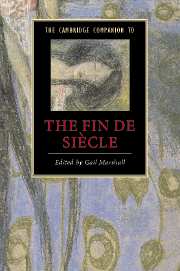Book contents
- Frontmatter
- Introduction
- 1 Psychology at the fin de siècle
- 2 Decadence and aestheticism
- 3 Sexual identity at the fin de siècle
- 4 Socialism and radicalism
- 5 Empire
- 6 Publishing industries and practices
- 7 The visual arts
- 8 The New Woman and feminist fictions
- 9 Realism
- 10 The fantastic fiction of the fin de siècle
- 11 Varieties of performance at the turn of the century
- 12 Poetry
- Guide to further reading
- Index
- Series List
3 - Sexual identity at the fin de siècle
Published online by Cambridge University Press: 28 September 2008
- Frontmatter
- Introduction
- 1 Psychology at the fin de siècle
- 2 Decadence and aestheticism
- 3 Sexual identity at the fin de siècle
- 4 Socialism and radicalism
- 5 Empire
- 6 Publishing industries and practices
- 7 The visual arts
- 8 The New Woman and feminist fictions
- 9 Realism
- 10 The fantastic fiction of the fin de siècle
- 11 Varieties of performance at the turn of the century
- 12 Poetry
- Guide to further reading
- Index
- Series List
Summary
The intense current interest in the fin de siècle has largely given us a view of the period as a perilously risqué epoch in attitudes about sex, sexuality and sexual identity. Many of the iconic figures of the period - the New Woman, the Bachelor-Dandy, the Decadent, the Femme Fatale - have assumed an enduring aura of risk, danger and transgression in erotic matters. Such fin de siècle 'myths' as Salome, Dracula, Dorian Gray, and Dr Jekyll and Mr Hyde reveal a cultural landscape given over to terrifying metaphors for sexuality. Degeneration, vampirism, syphilis, hysteria, these would seem to be the metaphors by which many late-Victorians thought of sexuality and the erotic self. Adding to this charged sexual atmosphere, the last decades of the century were dominated by controversies over declining birth rates and New Women, as well as sex scandals involving corruptible telegraph boys and upper-class Lotharios (the Cleveland Street case, in which a male brothel was exposed), and literary celebrities (the Wilde trials, in which a celebrated playwright was successfully prosecuted for sodomy). At the same time, we find at the end of the century such visionary enterprises as the Free Union and Birth Control movements, along with considerable utopian thought on sexuality in the writings of Olive Schreiner, Havelock Ellis, John Addington Symonds and Edward Carpenter, all of whom detailed the deprivations of modern marriage and erotic longing with an explicitness, boldness and experimentalism that would have been impossible in a mid-Victorian context.
- Type
- Chapter
- Information
- The Cambridge Companion to the Fin de Siècle , pp. 53 - 72Publisher: Cambridge University PressPrint publication year: 2007
- 4
- Cited by

